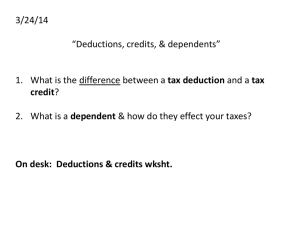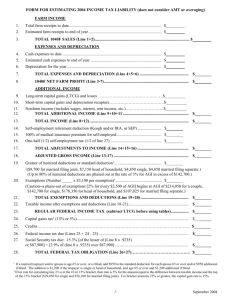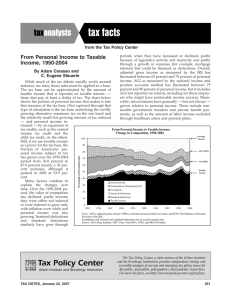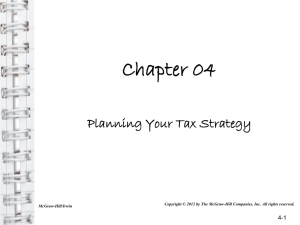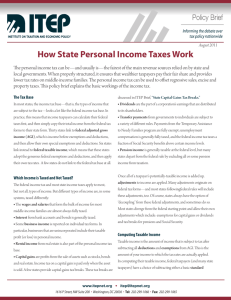Chapter 3: Taxes in your Financial Plan
advertisement
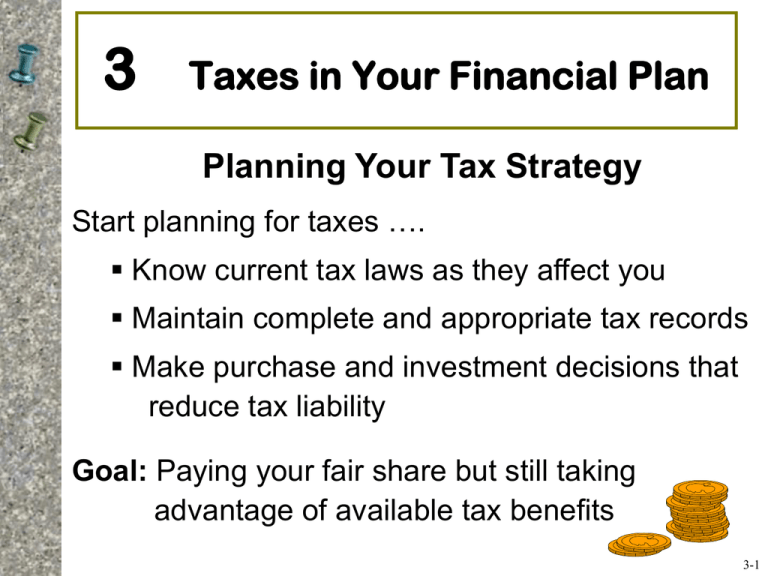
3 Taxes in Your Financial Plan Planning Your Tax Strategy Start planning for taxes …. Know current tax laws as they affect you Maintain complete and appropriate tax records Make purchase and investment decisions that reduce tax liability Goal: Paying your fair share but still taking advantage of available tax benefits 3-1 Objective 1 Identify the Major Taxes Paid by People in Our Society Taxes on Purchases – Sales tax and excise tax (e.g., gas, cigarettes) Taxes on Property – Real estate property tax – Personal property tax Taxes on Wealth – Federal estate tax – State inheritance tax Taxes on Earnings – Income tax and Social Security tax 3-2 The Progressive Nature of the Federal Income Tax • Progressive tax – takes a larger percentage of income from high-income taxpayers than low-income taxpayers. – Federal income tax • Regressive tax – as income rises, the tax demands a decreasing proportion of a person’s income as income increases. – State sales tax Objective 2 Calculate Taxable Income and the Amount Owed for Federal Income Tax Step 1: Determine AGI Gross income: Earned income (wages, salary, tips, bonuses) Investment income (dividends, interest) Passive Income (business limited partnerships) AGI = Adjusted Gross Income Gross income minus adjustments 3-4 Objective 2 Calculate Taxable Income Step 2: Computing Taxable Income Tax deduction = amount subtracted from adjusted gross income (AGI) to arrive at taxable income • Standard deduction • Itemized deductions 3-5 Calculate Taxable Income Exemptions Exemptions also subtracted from AGI – An exemption = a deduction for yourself, your spouse, and qualified dependents (increases annually for inflation) – After deducting deductions and exemptions from AGI, you have taxable income 3-6 Objective 2 Calculate Taxes Owed Step 3: Calculating Taxes Owed – Tax table rates = marginal rates • The tax rate paid on the last (or next) dollar of taxable income. – Example: • After deductions and exemptions, a person in the 35% tax bracket pays 35 cents in taxes for every dollar of taxable income in that bracket. 3-7 Objective 2 Calculate Taxes Owed The average tax rate = the total tax due divided by taxable income • Average tax rate < marginal tax rate • Example: – Taxable income = $40,000 – Total tax bill = $6,344 – Average tax rate = 15.9% » ($6,344 / $40,000) 3-8 Objective 2 Calculate Taxes Owed Alternative Minimum Tax (AMT) – Paid by taxpayers with high amounts of certain deductions and various types of income – Designed to ensure that those who receive tax breaks also pay their fair share of taxes 3-9 Objective 2 Calculate Taxes Owed Tax Credits – Amount subtracted directly from the amount of taxes owed – Examples: • Earned income credit • Foreign tax credits • Child and dependent care credits • Retirement tax credits (for savings plans) • Adoption tax credits • Hope Scholarship and Lifetime Learning credits 3-10 Tax Credit Versus Tax Deduction $100 Tax Credit Reduces Your Taxes by $100 $100 Tax Deduction Amount Your Taxes are Reduced is Based on Your Tax Bracket Example: $5,000 x .25 mtb = $1,250 of tax savings 3-11 Determining Your Tax Liability 3-12 Objective 2 Calculate Taxes Owed Step 4: Making Tax Payments • Payroll Withholding Based on the number of exemptions and the expected deductions claimed • Estimated Quarterly Payments Estimated tax payments made throughout the year based on income made during the year and reported on Form 1099. Who has to send the IRS estimated tax payments? 3-13 Objective 2 Calculate Taxes Owed Step 5: Watching Deadlines-Avoiding Penalties • Form 4868 automatic six-month extension – Submit estimated tax due with Form 4868 by April 15 • Penalties & Interest – Underpayment of quarterly estimated taxes may require paying interest on the amount owed – Underpayment due to negligence or fraud can result in penalties of 50 to 75 percent 3-14 Objective 3 Prepare a Federal Income Tax Return Every citizen or resident of U.S. and every U.S. citizen who is a resident of Puerto Rico is required to file income tax. • Five filing status categories: – Single or legally separated – Married, filing jointly – Married, filing separately – Head of household • Unmarried individual or surviving spouse who with a child or dependent relative – Qualifying widow or widower (2 years) 3-15 Which Tax Form Should You Use? ≈ 400 federal tax forms and schedules • Basically the choice is between 3 forms • 1040-EZ- (under $100k income, no itemizing/credits, no > $1,500 interest) 1040A- (IRA and child care credit, <$100k income, no itemizing) 1040- (“long form;” all income, credits, itemized deductions) • Which form to use? It depends… – Type of income – Amount of income – Number of deductions – Complexity of tax situation 3-16 Completing the Federal Income Tax Return Filing status and exemptions Income Adjustments to income Tax computation Tax credits Other taxes (such as from self-employment) Payments (total withholding and other payments) Refund or amount you owe • Refunds can be directly deposited to your bank account. • Payments may be directly debited from your bank account. Your signature = Most common filing error 3-17 Types of Tax Preparation Services • One-person, local offices to large firms such as H & R Block • “Enrolled agents” = Government- approved tax experts • CPA Tax Accountants • Attorneys Also tax preparation software, Free File Alliance (online filing), IRS services and VITA volunteers 3-18 Evaluating Tax Services Factors to consider: • Training and experience of tax professional? • Fee for preparing taxes and how determined? • Questionable deductions suggested? • If return is audited will the preparer represent the client? • Is tax preparation the main business activity or is it a front for other financial products? 3-19 Tax Service Warnings • Ultimately you are responsible for providing complete and accurate information – If your professional tax preparer makes a mistake, you are still responsible for paying the correct amount, plus any interest and penalties. • Hiring a tax preparer does not guarantee that you will pay the correct amount • Beware of tax preparers that offer refunds in advance • “Refund anticipation loans” can charge interest rates in excess of 300% 3-20 What if Your Return is Audited? ≈ 0.6% of all returns are audited • If you claim large or unusual deductions you are more likely to be audited. • Three types of audits: – Correspondence audit for minor questions – Office audit takes place at an IRS office – Field audit is the most complex, with an IRS agent visiting you at your home, your business, or your accountant’s office 3-21 Objective 4 Select Appropriate Tax Strategies • Tax Planning Strategies Practice Tax Avoidance – Legitimate methods to reduce your tax obligation to your fair share but no more (e.g., deductions & credits, HSAs, tax-deferred/tax-free investing) – Financial decisions related to purchasing, investing, and retirement planning are the most heavily affected by tax laws (e.g., home, IRAs) – Keep good tax records (W-2s, 1099s, receipts, copies) • Tax Evasion – Illegally not paying all the taxes you owe, such as not reporting all income 3-22 Tax Planning Strategies Minimizing Taxes If you expect Then you should Because The same or a lower tax rate next year Accelerate deductions into this year Greater benefit to higher rate The same tax rate Delay income into Delay paying taxes next year next year Delay deductions A higher tax rate next year Greater benefit Accelerate income Taxed at lower rate 3-23 Wrap Up • Chapter Quiz • Concept Check 3-1: Which Type of Tax? • Is it Taxable? Is it Deductible? • Concept Check 3-2- Tax Deduction or Tax Credit? • Concept Check 3-3- Which Tax Form? • Concept Check 3-4- Tax-Exempt or TaxDeferred?
